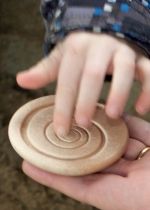Introducing Sensory Stones
Sensory Stones enable children to have sensory experiences by experimenting with raised and indented shapes and patterns. Here, author and play specialist Wendy Usher shares her ideas on introducing the stones into a setting and some sensory play activities.
Introducing the Sensory Stones
Introduce the stones to the children and encourage them to look at and to feel the stones. Ask the children to describe the stones to you. Help them by offering a range of appropriate adjectives. Use supportive questions such as, ‘Is the stone hard or soft?’ ‘Is it smooth or rough?’ ‘Can you feel curved or straight lines?’ ‘Can you feel ridges or hollows?’ Ask which shapes the children can see and feel. Work with the children to define the names of the patterns on the stones. Ensure that everyone is calling the stones by the same name.
 After you have introduced the stones, expand the activity by asking the children to close their eyes and then pass them a stone. Ask them to describe what is on the stone only by feeling.
After you have introduced the stones, expand the activity by asking the children to close their eyes and then pass them a stone. Ask them to describe what is on the stone only by feeling.
Stone sensations
Try to identify the stones by touch. Put the stones in a feely box or fabric bag. Ask the child to find you a bumpy stone or a stone with straight lines.
Expand this activity to incorporate a broader sensory experience by burying the stones beneath dry, fine sand. Ask the children to find the stones and to identify which one they have found. Experiment with putting the stones into a container filled with soapy water and hiding the stones beneath the bubbles. Ask the children if the stones feel different when they are in water. Also try rubbing a little hyper-allergenic liquid soap over the surface of the stone to create slippery sensation.
Put some of the stones in a fridge for a short time and some in hot water. Ask the children to feel the stones and decide which are cold which are warm. Ask them to tell you what shapes make them think of warm and cold.
These ideas are taken from the Sensory Stones leaflet written by Wendy Usher and forms part of our Sensory range.

 Register/Log in
Register/Log in
 Basket
Basket
